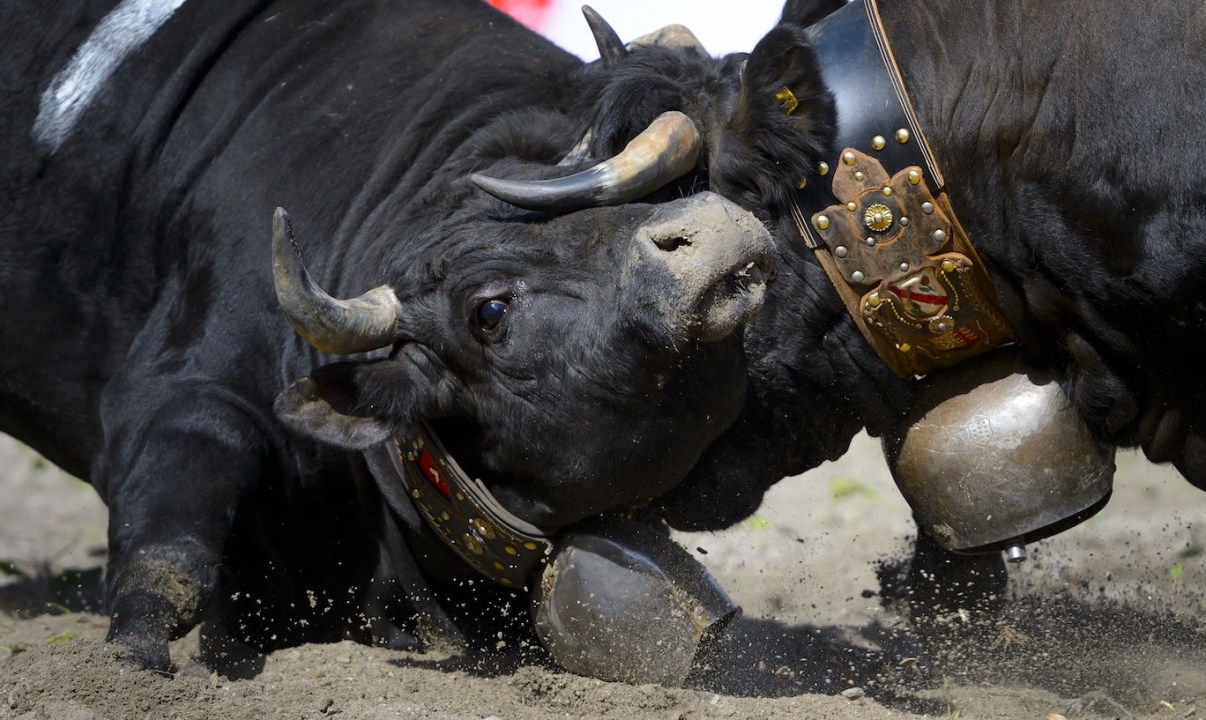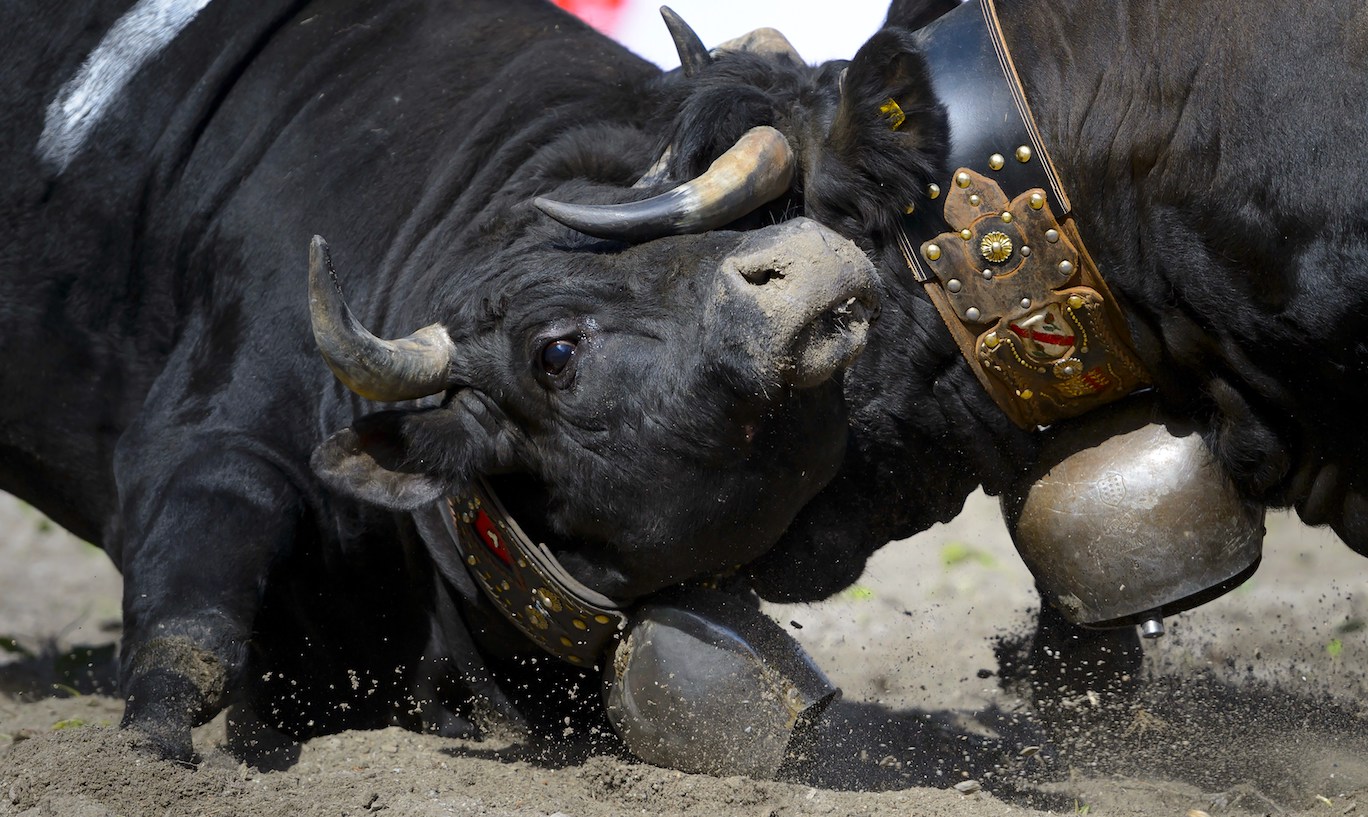I would never attend a Spanish bullfight. I find the ‘sport’ abhorrent, from the enthusiasm of the crowd for blood and gore to the inevitable killing of the poor, innocent bull. I know it’s a cultural thing but that doesn’t make it civilized. I’m even hoping, during the famous annual ‘running of the bulls’ in Pamplona, that some idiot aficionado is flipped in the air, run through by a bull’s horns and will then wake up and realize what it’s like to be on the losing side in such a match.
But Spain is not the only country in Europe where innocent bovines are attacked with a crowd cheering them on. It may be hard to believe, but in tranquil, fair-minded, neutral Switzerland, there exists a version of bullfights. The big difference is that these fights are carried out by cows and the only thing hurt is a cow’s pride.
Apparently, it was not unheard of to give cows white wine before the fight to enhance ferociousness
I had read about Swiss cow fights in La Tribune de Lausanne under ‘things to do in Switzerland from March through October.’ These events are only held once a year, at the first sign of spring and only in the Canton of Valais, where a special breed of feisty cow, the small, black, short-horned Eringer, is bred. They take place in Swiss pastures between Sierre and Martigny and are organised by local breeding syndicates. They can be attended by between 500 and 5,000 spectators, mostly Swiss from the Valais, who have a reputation for being as feisty as their cows.
Cow fights are a big deal for the Valaisans, where dairy farming is serious business. It is not uncommon for a farmer to travel a considerable distance to mate his cow with a bull who is known for siring a ‘queen’. Once a ‘queen’ is crowned the most bellicose bovine, her value can quadruple. Betting on who the champion will be is all part of this unique tradition.
I picked what seemed like a good-sized fight in Sierre and decided to make a day of it, watching the event (including what led up to the actual fight), talking to the locals and perhaps having a saucisson de veau en baguette. The connection with lunch and the participants in the fight did not escape me.
As I approached Sierre, I heard cow bells ringing en masse and became caught up in a cow jam, searching frantically for a parking space in a muddy pasture. It took 15 minutes to reach the arena. I should have brought my hiking boots. Nevertheless, I could still admire the nearby cows, garlanded with flowers for having produced the most milk. Flower-bedecked cows are not an unfamiliar sight in late summer and early autumn, when the herds come down from the high pastures, having spent months grazing and producing what provides Switzerland with two renowned products – cheese and chocolate. In talking to a native farmer I learned that only in the Valais are cows garlanded for picking the most fights. These bovine beauties are not only great milkers but fighters too.
After a cow is found to be a natural pasture fighter, she is singled out for preferential treatment by her owner, started on a diet of concentrated wheat and barley and made to run each day to build muscle. Apparently, it was not unheard of to give cows white wine before the fight to enhance ferociousness.
The crowd was decked out in local, colourful costumes, denoting what village or canton they came from and probably some other distinctions that only the Swiss themselves would recognise. I was an outsider, however, I was accepted politely with nods. The Swiss will welcome you if you have money for their banks and businesses, but to be assimilated by them takes years and, even then, there was – and still is – a quiet but distinctive national xenophobia. It’s not for nothing that Switzerland hasn’t been invaded for over seven centuries.
The president of the local syndicate welcomed everyone, bringing down the arena with a good pun: ‘Amusez-vous bien, mais j’espère qu’il n’y aura pas trop de vacherie [have fun and I hope there won’t be too much nonsense]’. Off-side betting stopped. Now it was up to the cows to perform. For a few moments, it seemed as if the cows didn’t know why they were there as they swatted flies with their tails and gently mooed. Suddenly, one charged and the fights were on. Dust exploded from the arena as the cows pawed the bare earth, cow eyes on cow eyes, pushing and snorting, horns locked. Cries from the crowd erupted not ‘Olé! ‘ but ‘allez Lisette’ or ‘allez Mignonne.’
As soon as a match was won, the loser was led dolefully away to the jeers of the crowd. The elimination proceeded, each remaining cow had to prove herself with the remaining combatants. Jeers and corks were thrown into the arena in equal proportion. Who says the Swiss don’t get excited?
Finally, there was a clear winner. She was led away in glory, bedecked with a fine leather collar and a new bell, inscribed with her victory, by her happy, intoxicated owner.
The morning after, a piece I had written for an English language paper in France was published. I was in the kitchen listening to la Radio Suisse Romande, as I did most mornings, and heard this: ‘A foreign journalist living in Lausanne and writing for the International Herald Tribune on Swiss culture has accused our Valaisan farmers of forcing their cows to drink the local white wine to increase their ferociousness during the annual Swiss cow fights in their canton. The Office of Tourism in the Valais has denied that Swiss farmers give wine to their cows and the journalist, who has reported this information, is mistaken in her information.’
At any moment, I expected a knock on the door from the local gendarmerie, demanding to see my residence permit.
Thankfully none came. There was, however, a small article in la Tribune de Lausanne the next day, summarizing the Swiss objections to any Swiss cow being drunk. Buried in a back page was a reader’s comment: ‘Of course, Valaisan farmers give their cows wine before the fights. Everyone knows that.’
Cow Fights schedule
6 August, Saas-Fee
20 August, Tortin
23 September, Probé Arena, Le Châble
24 September, Arena Goler, Raron
1 October, Foire du Valais, Martigny







Comments